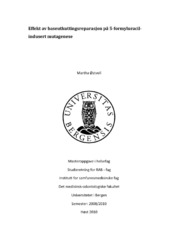Effekt av baseutkuttingsreparasjon på 5-formyluracil-indusert mutagenese
Master thesis
Permanent lenke
https://hdl.handle.net/1956/4873Utgivelsesdato
2010-11-30Metadata
Vis full innførselSamlinger
Sammendrag
5-Formyluracil (fU) is an oxidation derivate of the DNA-base thymine. It can emerge in the organism by attack of reactive oxygen species, either endogenously or exogenously. Examples of exogenous agents are irradiaton or certain chemicals. Because fU is a derivate of thymine, it makes the most stable base pair with adenine. But because it also quite easily basepairs with guanine, it has been proven to be mutagenic. And therefore it is important that it is removed from the cell´s DNA. In vitro experiments have demonstrated that the main DNA repair system to repair fU in the organism is base excision repair (BER). The main glycosylase in BER in E. coli to excise fU from the DNA helix is 3-methyladenine-DNA glycosylase II (AlkA). One goal for our research group has been to find out if the same happens in vivo. This has been done by exposing wildtype and alkA--mutant of E. coli towards fU. In these experiments it turned out that certain basesubstitutions were promoted in the wildtype compared to the mutant. The only difference between the two strains is that the gene coding for AlkA, the alkA-gene, is intact in the wildtype but defect in the mutant. Because of these findings, the following research question has arisen: Does the repair enzyme AlkA under certain circumstances function more as a mutation promoter instead of a restrainer. This possible discovery sheds new light on present knowledge of DNA repair. Since DNA repair systems in different organisms have many similarities, this knowledge may be extrapolated to humans. 5-Formyluracil (fU) er en oksidering av DNA-basen tymin. Den kan induseres av reaktive oksygenderivater som oppstår endogent eller fra forskjellige eksogene agenser. Eksempler på det siste er stråling eller visse kjemikalier. Fordi fU er en modifisert utgave av tymin, baseparer den best med adenin i DNA-heliksen. Men den kan også feilbasepare med guanin. Derfor regnes den oksiderte basen som mutagen. På grunn av det er det viktig at fU blir fjernet fra arvematerialet. In vitro-studier har funnet at fU hovedsakelig blir reparert av baseutkuttingsreparasjonssystemet (BER). Hovedglykosylasen i BER i E. coli som klipper ut fU fra DNA-tråden er 3-metyladenin-DNA-glykosylase II (AlkA). Vår forskergruppe har ønsket å finne ut om det samme er tilfellet in vivo. Det er blitt gjort ved å eksponere villtype og alkA--mutant hos E. coli overfor fU. I den forbindelse er det funnet at visse basesubstitusjoner promoteres i villtypen i forhold til mutant. Den eneste forskjellen mellom de to E. coli-typene er at det genet som koder for AlkA, alkA-genet, er intakt i villtype men defekt i mutanten. Forskningsspørsmålet har derfor blitt om AlkA i noen tilfeller kan være mutasjonsfremmende i stedet for hemmende. Dette setter i så fall kunnskaper om DNA-reparasjonssystemer i et helt nytt lys. Fordi slike systemer er ganske like i alle organismer, kan slik kunnskap gjerne også overføres til menneskekroppen.
Utgiver
The University of BergenOpphavsrett
Copyright the author. All rights reservedThe author
